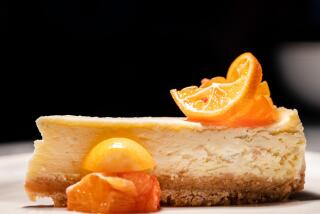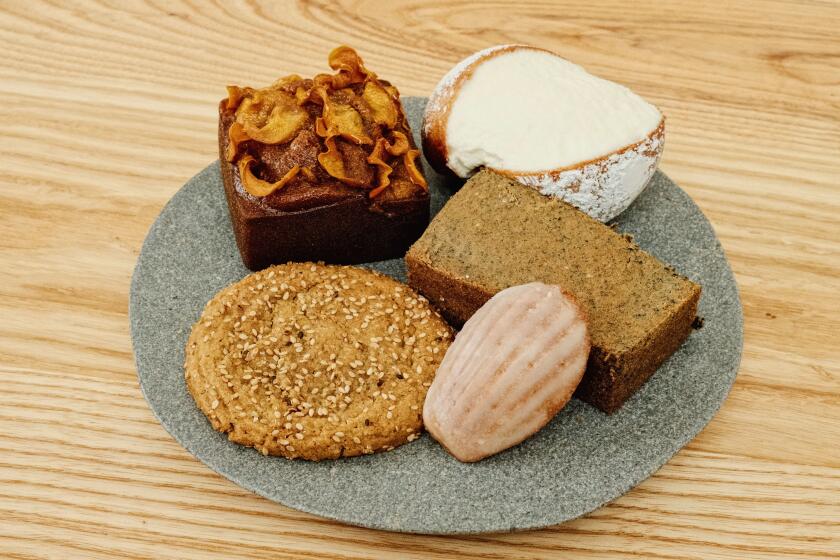Minding his curds and whey
The 5-inch round of cheese was slightly orange, as it should have been, I guess. I cut it in half and, hoping I wouldn’t end up in the hospital, I spread the creamy cheese on some bread. Hey, this was good! It tasted like … Camembert?
This was the first cheese I’d ever made from scratch. I basically had no idea what I was doing. Not only did I not kill anyone, but I also actually made something that tasted pretty good, which is a testament either to how easy it is to make cheese or to my dumb luck.
It had all started a few months earlier, when I saw “liquid vegetable rennet” on a little packet at Whole Foods. I thought, “Make cheese,” because, well, that’s what rennet is used for. Rennet contains enzymes extracted from the stomach of mammals, including one that coagulates milk, causing it to separate into solids (curds) and liquid (whey). Rennet can also be extracted from some plant matter, and that’s what I used.
Although I had read many articles and books by artisanal cheese makers talking about milk — raw versus pasteurized, cow versus sheep — the biggest limitation I found when I made my first cheese was the storage and equipment requirements. I had to jury-rig most everything.
The first thing to overcome in making cheese at home is the skepticism of your family. You will need to take over a portion of the refrigerator and basically annoy people for at least eight weeks — or, in my case, nine months.
This is what I did: First, I read the notes given to me by several cheese makers, including my father’s sheep-farming neighbor from when he lived in France years ago.
The problem with making your own cheese is that there is too much information and it’s hard to judge which advice to take, so I decided to adapt my recipe from the guidelines found for cheese making in my beat-up copy of Anita May Pearl’s “Completely Cheese: The Cheese Lover’s Companion,” published in 1978.
Making cheese is not hard, but it is complicated and involves a lot of heating, cooling, salting and turning. Fortunately, there’s a lot of letting the cheese sit unattended as well.
The first step is preparing the curd. I started with a mixture of whole milk, heavy cream and a little yogurt. After heating it, I added the rennet and let it sit again. Then I broke it up into curds, first cutting it with a knife, then (after letting it sit yet again), whisking it gently. By the end, I had curds that were about 1/8-inch big (the book said they should have been 1/4 inch — whatever).
The curd prepared, I started to make the cheese. With a fine-mesh sieve, I lifted the curds from the whey and poured them into two cheesecloth-lined, perforated plastic molds that I had salvaged from some Angelo & Franco ricotta containers and set the molds on a rack in my oval roasting casserole. I leveled them off, covered them with wax paper and left them to sit for a day at 72 degrees (letting Santa Monica’s mild climate control the temperature for me).
The next day, I rubbed a teaspoon of salt over the top and sides of each cheese with my fingertips and set them on the top shelf of my refrigerator, which I had reset to 58 degrees (meaning our milk went bad rather quickly). After one day, I turned the cheeses, salted the untreated surfaces and left them for another day.
Cheese needs a constant humidity, so I filled the casserole two-thirds full with water, put the cheeses on a metal grate and rested that on top of a bowl that was tall enough to hold the cheeses above water. I covered it with the lid to the pan, and then it was back in the refrigerator to rest undisturbed for three more days.
After that it was pretty easy — I let the cheeses sit for eight weeks, turning them once a day. Each time I turned the cheeses, I washed the grate and dampened the tops with a little salt water, using a paper towel or cloth.
Soon, a white smear of rind developed. Then the rind turned pinkish, meaning it was time to eat. I cut the first cheese into pieces. It tasted like Camembert. I called it Cliff-embert. Not bad for a first try.
So, I decided to push my luck with the second cheese, maturing it even longer — a full nine months — dampening it with vinegar and turning it once a day.
By the time we ate the second cheese, the rind was a burnt orange with black spots, which the book said was fine — it’s only if you start to see blue spots that the cheese is spoiling. Perhaps, but this one ended up being overripe and slightly ammoniac. This was probably due to the lack of circulating air, I learned after the fact.
I served it to dinner guests who were very polite.
Wright is a James Beard Award-winning cookbook author. His latest book, “Hot and Cheesy,” is about cooking with, not making, cheese.
More to Read
Eat your way across L.A.
Get our weekly Tasting Notes newsletter for reviews, news and more.
You may occasionally receive promotional content from the Los Angeles Times.










